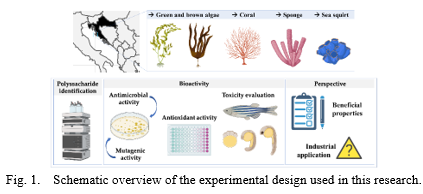MARINE-DERIVED POLYSACCHARIDES FROM ADRIATIC SEA: INVESTIGATION OF DIVERSE BIOLOGICAL ACTIVITIES
Introduction
Among a large number of marine extracts and different isolated bioactive compounds, polysaccharides are recognized as one of the most promising sources of different biological activity (Shi et al, 2017; Gopu & Selvam, 2020). Their structure and biological activity are highly influenced by growth location and harvesting season that cause even intra-species variation, thus offering an inexhaustible source of novel bioactive compounds (Jiao et al., 2011) with unique physiological and chemical properties, including anti-inflammatory, antioxidant, antimicrobial, antiviral, anti-coagulant, and antitumor activities (Lee et al, 2017). Most recently, sulfated polysaccharides (fucoidans) extracted from the brown algae Saccharina japonica were able to effectively inhibit SARS-CoV-2 in vitro (Kwon et al, 2020). Nevertheless, marine-derived polysaccharides are still under-exploited, thus paving the way for a new trend in the discovery of compounds from a sustainable source. This study aimed to conduct comprehensive research and determine biological activities (antioxidant, antibacterial, and antifungal) of water-soluble polysaccharide extracts from 10 marine species from the Croatian coast of the Adriatic Sea: 2 green algae (Ulva lactuca and Codium bursa), 5 brown algae (Fucus virsoides, Padina pavonica, Cystoseira barbata, Halopteris scoparia, and Cystoseira compressa), 1 coral (Eunicella cavolini), 1 sea squirt (Aplidium conicum) and 1 sponge (Chondrosia reniformis), along with embryotoxicity and mutagenic potential to determine their safety for non-target organisms and humans.
Materials and methods
Ten marine organisms were collected from the coastal area of Croatia. Extraction of polysaccharides was conducted in acidic conditions (H2SO4) under high temperature (80°C). Dry residues of polysaccharide extracts were dissolved in a distilled water. Chemical characterization was performed using high-performance liquid chromatography (HPLC). Antioxidant activity was evaluated by implementing four in vitro assays - oxygen radical absorbance capacity (ORAC), reduction of radical cation (ABTS·+), 2,2-diphenyl-1-picryl-hydrazyl-hydrate (DPPH) assay, and ferric reducing antioxidant power assay (FRAP). The mutagenic potential was evaluated by AMES test following ISO 16240 (2005) while anti-microbial activity was analyzed by the implementation of disk diffusion and microdilution methods on 4 bacterial strains and 1 yeast strain. The toxicity of samples was determined using the zebrafish embryotoxicity test (OECD 236, 2013).
Results
The highest extraction yields were obtained for A. conicum (21.98%) and U. lactuca (18.89%). Chemical analysis revealed a high abundance of different polysaccharides within each sample. No clear halos were observed in the disk diffusion assay, but C. reniformis (42.0 ± 1.3 %), C. barbata (45.7 ± 12.4 %), and F. virsoides (37.7 ± 4.6 %) were able to inhibit the growth of B. subtilis, while C. reniformis (34.0 ± 1.2 %) and C. barbata (24.0 ± 3.3 %) showed antifungal activity against C. albicans. The highest antioxidant activity was obtained for C. barbata and C. compressa extracts using DPPH, ABTS, and FRAP assays, while ORAC assay revealed the highest activity for C. reniformis and H. scoparia extracts. Tested polysaccharide extracts showed no mutagenic or embryotoxic potential, with an exception for C. reniformis extract.
Discussion and conclusion
The optimization of the polysaccharide extraction is vital for obtaining high extraction yields with no interfering compounds. Pretreatment with organic solvents for the removal of polyphenols and pigments was conducted and extraction in acidic conditions followed by precipitation was performed. All samples showed a relatively high extraction yield, from 5.66 to 21.98 %. The chemical analysis supported these findings with specific chromatograms without interfering peaks. Different organisms have shown to have diverse polysaccharide compositions which contributed to various biological activities. Although antimicrobial activity was not present for most of the tested extract, some activity was obtained and was positively correlated with the increased antioxidant activity. All samples had medium to high antioxidant activity, which shows the potential usage of these compounds in different industrial applications. However, this application is limited if the extracted compounds are toxic or harmful. Combined with the AMES mutagenic test, the obtained results of embryotoxic testing have proven the safety of almost all isolated polysaccharide extracts, except for C. reniformis extract, thus indicating the importance of marine-derived compounds in different areas of research and applications, from food supplements to higher pharmaceutical development.
References
Shi Q., Wang A., Lu Z., Qin C., Hu J., and J. Yin. 2017. Overview on the antiviral activities and mechanisms of marine polysaccharides from seaweeds. Carbohydrate Research 453–454: 1-9.
Gopu M., and K. Selvam. 2020. Polysaccharides from marine red algae Amphiroa rigida and their biomedical potential: An in-vitro study, Biocatalysis and Agricultural Biotechnology 29: 101769.
Jiao G., Yu G., Zhang J., and H. S. Ewart. 2011. Chemical structures and bioactivities of sulfated polysaccharides from marine algae, Marine Drugs 9: 196–233.
Lee Y.-E., Kim H., Seo C., Park T., Bin Lee K., Yoo S.-Y., Hong S.-C., Tae Kim J., and J. Lee. 2017. Marine polysaccharides: therapeutic efficacy and biomedical applications, Archives of Pharmacal Research 40: 1006–1020.
Kwon P. S., Oh H., Kwon S. J., Jin W., Zhang F., Fraser K., Hong J. J., Linhardt R. J., and J. S. Dordick. 2020. Sulfated polysaccharides effectively inhibit SARS-CoV-2 in vitro. Cell Discovery 6: 50.
International Organization for Standardization (ISO). (2005). ISO 16240:2005 - Water quality — Determination of the genotoxicity of water and wastewater — Salmonella/microsome test (Ames test). In International Standard International Standard (Vol. 2005).
OECD. (2013). Test No. 236: Fish Embryo Acute Toxicity (FET) Test. OECD Guidelines for the Testing of Chemicals, Section 2, OECD Publishing, July, 1–22.
